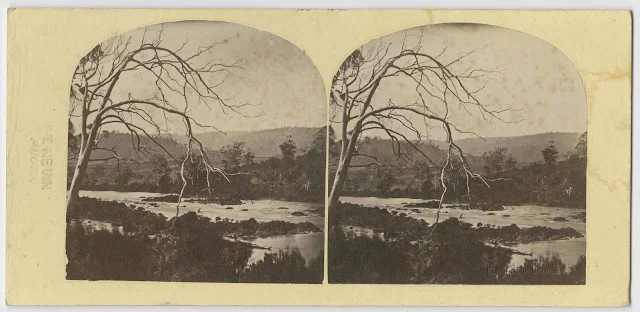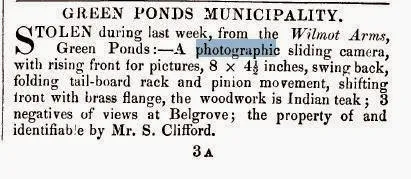STEREOGRAPHS Tasmania 1860s-1870s
The Stereographs
Thomas J. Nevin's standard stereographic views included these photographs taken in the upper Derwent Valley from the late 1860s to the mid 1870s. This stereograph by Thomas Nevin, titled Salmon Ponds, at Plenty near New Norfolk, which is held by the Tasmanian Museum and Art Gallery is very similar to one by Samuel Clifford. Several views of the upper reaches of the Derwent were taken by Nevin, and reprinted by Clifford.

TMAG Catalogue notes (online until 2006)
Ref: Q1994.56.7
ITEM NAME: Photograph:
MEDIUM: sepia stereoscope salt paper print ,
MAKER: T Nevin [Artist];
DATE: 1870c
DESCRIPTION : Salmon Ponds at Plenty near New Norfolk
INSCRIPTIONS & MARKS: Impressed on front: T Nevin/ photo

TMAG Catalogue notes (online until 2006)
Ref: Q1994.56.21
ITEM NAME: Photograph:
MEDIUM: sepia stereoscope salt paper print ,
MAKER: T Nevin [Artist];
DATE: 1870s
DESCRIPTION : Scene near New Norfolk ?
INSCRIPTIONS & MARKS: Impressed on front: T Nevin/ photo

"Junction of Plenty and Derwent Rivers"
TMAG Ref: Q1994.56.14
sepia stereo salt paper print , 1870s
The TMAG has another stereo titled Junction of Plenty and Derwent Rivers which belongs in this series, at present unattributed. It is likely to be one of Thomas J. Nevin's, and many more stereographs which have a Samuel Clifford attribution in public collections are likely to be reprints of Nevin's negatives. The State Library of Tasmania holds dozens of stereographs in a Clifford Album which include Clifford's reprints of Nevin's work around Port Arthur 1872-1873.
The Partnership
Thomas Nevin and Samuel Clifford were close friends and colleagues over a period dating from ca. 1865 to Clifford's death in 1890. A group photograph of Thomas and Elizabeth Nevin, seated, with Thomas' younger brother Constable John (Jack) Nevin extreme right standing next to a man who was probably Samuel Clifford, could have been taken at the wedding of Thomas and Elizabeth in July 1871 at the Wesleyan Chapel, Kangaroo Valley, Hobart.


Thomas and Elizabeth Nevin group portrait, July 1871
Seated, Thomas and Elizabeth Nevin
Standing extreme right younger brother Jack Nevin
Copyright © KLW NFC Imprint Private Collection 2009 ARR


Hand coloured carte-de-visite, full length of teenage girl holding a sprig of holly
Verso inscription: Clifford & Nevin Hobart Town ca late 1860s
Copyright © The Private Collection of G.T. Harrisson 2006
At some point during their long relationship, these two photographers signed the verso of several studio portraits "Clifford & Nevin, Hobart Town", extant examples of which are held in private collections and at the Queen Victoria Museum and Art Gallery. It is likely that they printed these scenes for the local and intercolonial tourist trade, sharing their stock of negatives and prints from as early as 1865, and that "authorship" was secondary to the successful turnover of the commercial product. Many of Thomas J. Nevin's negatives were acquired and reprinted by Samuel Clifford in 1876 when Nevin sublet one of his studios, the former studio of Alfred Bock at 140 Elizabeth St, Hobart, to join the civil service full-time with the Hobart City Council as keeper of the Hobart Town Hall and police photographer with the Municipal Police Office, housed within the Hobart Town Hall.
Samuel Clifford inserted a notice in the Hobart Mercury, 17th January, 1876, stating that T. J. Nevin, in retiring from "Photography" had transferred his interest in his negatives to Clifford's studio, and that he would reprint any for Nevin's clients and friends on request. Nevin had retired from commercial photography while employed at the Hobart Town Hall. On leaving that position he continued working for police on contract from his studio at New Town until 1886.

TRANSCRIPT
PHOTOGRAPHYSource: Mercury, 17th January, 1876
T.J. NEVIN, in retiring from the above, begs to thank his patrons for the support he has so long received from them, and also to state that his interest in all the Negatives he has taken has been transferred to Mr S. CLIFFORD, of Liverpool-street, to whom future applications may be made.
In reference to the above, Mr T.J. Nevin's friends may depend that I will endeavour to satisfy them with any prints they may require from his negatives.
S. CLIFFORD
The reason for this advertisement was to underscore Nevin's status as a full-time civil servant which was announced later in January 1876. As a civil servant, he was not entitled to further remuneration - "interest" as it is termed here - from his commercial photography. However, he was not long retired from commercial practice when he was called on again to do photographic work for the Municipal Police Office, located at the Town Hall, with duties as well at the Hobart Gaol. His earlier work for the Colonial Government on commission as a government contractor was to photograph prisoners on arrest, arraignment, incarceration, and discharge from the prison system. And by 1880, he was producing commercial work once more with Henry Hall Baily, another close friend while still a civil servant at the Town Hall, a fact noted by The Mercury, December 4th, 1880.
Theft of Clifford's camera 1878
Samuel Clifford's name appears only twice in the weekly police gazettes, called Tasmania Reports of Crimes Information for Police between the years 1866-1880, and in both instances because he was a victim of theft: some silver cutlery and a table cloth were stolen from his house and reported on 17th October 1873, and most wrenching of all, his camera was stolen while staying at the Wilmot Arms at Green Ponds, in the district where these stereographs of the Salmon Ponds were taken. No doubt Samuel Clifford and Thomas Nevin made many trips to the Green Ponds area, and since Clifford reprinted so many of Nevin's commercial negatives from 1876, placing an accurate date and even a sole attribution to Clifford on the extant albums of views etc is far from straightforward.

Notice in the police gazette of 15th November, 1878:
Samuel Clifford's camera stolen from the Wilmot Arms at Green Ponds.
RELATED POSTS main weblog
- Thomas Nevin's stereography
- Red and violet: the impact of Brewster stereoscopy
- Stereographs by Clifford & Nevin at 'Narryna'
- Tasmanian Museum and Art Gallery databases
- Six of Nevin’s salt paper stereos at TMAG
- T. Nevin & Samuel Clifford identical views
- Rocking Stone party, Mt Wellington
- At the Salmon Ponds and Plenty
- Ferns, convicts and Charles Darwin
- Hobart Town from Lime Kiln Hill


